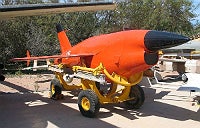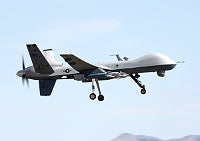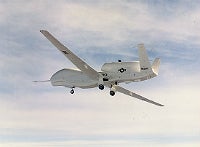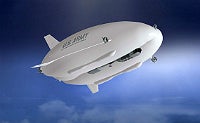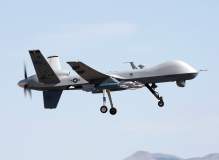
Early history: from balloons to radio control
From the earliest days of aircraft, inventors looked at ways they could be exploited for warfare without endangering the lives of pilots.
The earliest cited example dates back to the mid-19th century, when the Austrian military attacked the enemy Italian city of Venice using balloons laden with explosives, but being entirely at the whim of the wind, a dangerously unpredictable flight-path saw many explode over Austrian territory.
Aircraft evolved rapidly during the First World War, with unmanned concepts soon following, culminating in the Kettering Bug, a biplane which flew on a pre-set course using an on-board gyroscope and altimeter.
A similar idea underpinned perhaps the most infamous of Second World War drones, the V-1 Flying Bomb or Doodlebug, which devastated London and other British cities.
Radio controlled aircraft also evolved during the war and were used for targets, and, hesitatingly, in combat, with the most advanced controlled via a television camera.
Reconnaissance UAVs truly came into their own during the Vietnam War, with the US estimated to have flown more than 5,000 surveillance missions using the plane-launched AQM-34 Ryan Firebee.
But, perhaps the conflict which truly thrust UAVs into the modern era was the so-called Yom Kippur war, in which Israel used them in a coordinated assault alongside piloted aircraft to successfully shoot down up to 334 Arab aircraft in air-to-air combat, for the reported loss of only five Israeli planes. Israel remains one of the most innovative and enthusiastic developers of UAVs to date.
Modern warfare
Impressed by Israel’s success, the US quickly acquired a number of UAVs, and its Hunter and Pioneer systems are direct derivatives of Israeli models. The first ‘UAV war’ was the first Gulf War: according to a May 1991 Department of the Navy report: "At least one UAV was airborne at all times during Desert Storm."
Since the first Gulf War there has not been a conflict where UAVs were not deployed. The global war on terrorism has seen the expanding use of all forms of UAVs.
As the white heat of innovation died down, there was time to reflect and learn from previously fielded programmes. The Pioneer, for example, had never been used by Israel aboard ships and US Navy attempts to adapt it met with limited success. It did not offer an automatic take-off, landing and mission capabilities, depended on a ground control station (GCS) and lacked weatherproof avionics – which wasn’t an issue in desert environments. Electromagnetic interference from ship systems also caused a number of crashes.
After the Gulf War successfully demonstrated their utility, global militaries invested widely in the domestic development of combat UAVs, perhaps none more so than the US. The General Atomics MQ-1 Predator UAV was developed in the early 1990s through an Advanced Technology Demonstrator Programme (ATDP) for reconnaissance and forward observation roles, but the US Air Force adapted it to carry Hellfire missiles.
Rushed into deployment before completing its full combat-readiness test suite, it has been used in a number of major conflicts, including the Balkans, Iraq, Afghanistan and Libya. It has also been controversially been used against Al Qaeda operatives in non-combat zones including Pakistan, where up to a third of casualties are reported to have been civilians.
The Predator is another example of on-the-wing evolution – during the Balkans conflict it proved not to be weather resistant so was fitted with a de-icing system, and later variants have weather resilience incorporated. The British Royal Air Force has also employed Predators widely in Afghanistan since 2008.
Often operated alongside the Predator is the Northrop Grumman RQ-4 Global Hawk surveillance aircraft, developed to replace the Lockheed U-2 spy plane from the 1950s.
However, cost-cutting measures and reliability issues have seen its fortunes wax and wane, with, at one point, U-2s being re-instated to replace it. The Pentagon cancelled Global Hawk Block 30 in January 2012 as its sensor suite was not as capable as the manned U-2, but announced plans to increase the procurement of the more capable Block 40 variant.
Vertical takeoff UAVs – usually rotary wing or tiltrotor – took longer to be adopted by the military due to the special skills required to pilot them.
The US Armed Forces have enjoyed great success with the Northrop Grumman MQ-8 Fire Scout UAV for reconnaissance, situational awareness and precision targeting.
However, the aircraft were briefly grounded at the beginning of 2012 after two crashed within a week, but they were re-established shortly afterwards. The Lockheed Martin and Kaman Aerospace collaboration K-MAX Unmanned Multi-Mission Helicopter was widely used in Afghanistan as an optionally piloted aerial truck, which could deliver supplies to the ground or drop them by parachute.
Flying into the future
The introduction of UAVs into military service had a rocky start, but now the technology is proven they form an essential part of the armoury for any war, especially given the asymmetric nature of recent conflicts making ground combat increasingly treacherous.
Having started off carrying out simple functions then broadening out into multipurpose aircraft, the military can now afford the luxury of a fleet of specialised UAVs. The UAVs of the future can broadly be divided into three categories; high-altitude, long endurance (HALE) surveillance, combat, and miniature spy UAVs.
Whereas the Global Hawk could fly for 24 hours at a time, future HALE UAVs may stay aloft for weeks or even months at a time. QinetiQ’s solar-powered Zephyr HALE UAV flew for 14 days in 2010, beating the previous record by more than a factor of five, and at a record altitude of 21,562 metres.
Long Endurance Multi-Intelligence Vehicle (LEMV), the optionally manned football-pitch sized hybrid airship collaboration between Northrop Grumman and Hybrid Air Vehicles, may not fly as high or as long, but it offers some impressive credentials.
Flying at 20,000 feet, it provides a 2,000 mile radius of action and is bristling with an electronic payload powered by the 16Kw of power it supplies.
It can be sent ahead of operations to provide geostationary communications support to locations beyond line of sight. LEMV undertook its first 90-minute crewed flight in 2012.
Though the Predator has attracted criticism for its involvement in civilian deaths and the ethical dilemma of being able to target the enemy without putting a pilot at risk, remotely piloted warplanes are still high on the military’s wishlist.
In July, the UK’s £143m unmanned combat air system demonstrator (UCAS-D) Taranis successfully passed a series of tests, which enabled it to pass into flight testing in 2013.
Built by BAE Systems, the semi-autonomous aircraft carries weapons to engage aerial or ground targets and stealth properties enabled in part by a Rolls-Royce low-observable (LO) propulsion system that reduces its infrared signature. Similar in design, the US Navy selected Northrop Grumman’s X-47B for its UCAS-D programme.
Despite not being shortlisted for any specific military programme, Boeing is developing its Phantom Ray UCAS from its own funds.
China seems to be a generation behind – at the 2012 Zuhai air show it unveiled its Wing Loong (Pterosaur) UAV, which is more like the Predator in design than modern stealth aircraft.
At the other end of the scale, UAVs are getting smaller and more agile to enable combatants to gather intelligence from hard to reach areas, such as in buildings and through tunnels.
Designers often take their inspiration from nature to produce tiny UAVs that can hover, perch or dart forward – AeroVironment‘s Nano Hummingbird and TechJect Dragonfly both fly like their namesakes from the natural world. AeroVironment is also behind the first man-portable tactical armed drone, the tube-launched 2.5kg Switchblade, which went into operation with the US Army in September 2012.
With 50 years of practical military use behind them, UAVs are here to stay and are likely to play a vital role in all future combat operations.
As designers learn from the success and shortcomings of their predecessors, we can expect ever more diverse and specialised designs, boasting impressive duration, lethality, stealth and agility.
Related content
Kamikaze drones – the military robots set to self destruct
Military robots can now be produced cheaply enough to have them crash into enemy targets rather than engage them.
Locked and loaded – the ethics of armed drones
The increased use of armed drones raised issues about the ethics of directing aerial attacks from miles away.


